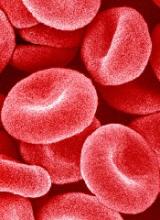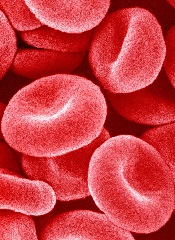User login
Researchers say they have discovered a new mechanism through which globin genes are expressed.
Their discovery, described in Cell Research, indicates that cellular stress is needed for the production of hemoglobin.
“Surprisingly, we have revealed an entirely new mechanism through which hemoglobin gene expression is regulated by stress,” said study author Raymond Kaempfer, PhD, of the Hebrew University of Jerusalem in Israel.
“An intracellular signal, essential for coping with stress, is absolutely necessary to allow for hemoglobin production. That stress signal is activated by the hemoglobin gene itself. Although we have long known that this signal strongly inhibits protein synthesis in general, during hemoglobin gene expression, it first plays its indispensable, positive role before being turned off promptly to allow for massive hemoglobin formation needed for breathing.”
To produce a globin protein molecule, the DNA of the globin gene is first transcribed into a long RNA molecule from which internal segments must be spliced out to generate the RNA template for protein synthesis in the red cell.
The researchers found that, for each of the adult and fetal globin genes, the splicing of its RNA is strictly controlled by an intracellular stress signal.
The signal, which has been known for a long time, involves an enzyme called PKR. This enzyme remains silent unless it is activated by a specific RNA structure thought to occur only in RNA made by viruses.
What the researchers discovered is that the long RNAs transcribed from the globin genes each contain a short intrinsic RNA element that is capable of strongly activating PKR.
Unless the PKR enzyme is activated in this manner, the long RNA cannot be spliced to form the mature RNA template for globin protein synthesis.
Once activated, PKR will place a phosphate onto a key initiation factor needed for the synthesis of all proteins, called eIF2-alpha. That, in turn, leads to inactivation of eIF2-alpha, resulting in a block in protein synthesis. This process is essential for coping with stress.
The researchers discovered that, once activated, PKR must phosphorylate eIF2-alpha, and that phosphorylated eIF2-alpha is essential to form the machinery needed to splice globin RNA.
In the splicing process, removal of an internal RNA segment causes the mature RNA product to refold such that it no longer will activate PKR. This allows for unimpeded synthesis on this RNA of the essential globin protein chains at maximal rates, which allows for effective oxygen breathing.
In other words, the ability to activate PKR remains transient, serving solely to enable splicing.
Thus, the researchers have demonstrated a novel, positive role for PKR activation and eIF2-alpha phosphorylation in human globin RNA splicing, in contrast to the long-standing negative role of this intracellular stress response in protein synthesis.
The realization that stress is essential may have implications for how we understand hemoglobin expression.
“What this boils down to is that, even at the cellular level, stress and the ability to mount a stress response are essential to our survival,” Dr Kaempfer said. “We have long known this in relation to other biological processes, and now we see that it is at play even for the tiny molecules that carry oxygen in our blood.” ![]()
Researchers say they have discovered a new mechanism through which globin genes are expressed.
Their discovery, described in Cell Research, indicates that cellular stress is needed for the production of hemoglobin.
“Surprisingly, we have revealed an entirely new mechanism through which hemoglobin gene expression is regulated by stress,” said study author Raymond Kaempfer, PhD, of the Hebrew University of Jerusalem in Israel.
“An intracellular signal, essential for coping with stress, is absolutely necessary to allow for hemoglobin production. That stress signal is activated by the hemoglobin gene itself. Although we have long known that this signal strongly inhibits protein synthesis in general, during hemoglobin gene expression, it first plays its indispensable, positive role before being turned off promptly to allow for massive hemoglobin formation needed for breathing.”
To produce a globin protein molecule, the DNA of the globin gene is first transcribed into a long RNA molecule from which internal segments must be spliced out to generate the RNA template for protein synthesis in the red cell.
The researchers found that, for each of the adult and fetal globin genes, the splicing of its RNA is strictly controlled by an intracellular stress signal.
The signal, which has been known for a long time, involves an enzyme called PKR. This enzyme remains silent unless it is activated by a specific RNA structure thought to occur only in RNA made by viruses.
What the researchers discovered is that the long RNAs transcribed from the globin genes each contain a short intrinsic RNA element that is capable of strongly activating PKR.
Unless the PKR enzyme is activated in this manner, the long RNA cannot be spliced to form the mature RNA template for globin protein synthesis.
Once activated, PKR will place a phosphate onto a key initiation factor needed for the synthesis of all proteins, called eIF2-alpha. That, in turn, leads to inactivation of eIF2-alpha, resulting in a block in protein synthesis. This process is essential for coping with stress.
The researchers discovered that, once activated, PKR must phosphorylate eIF2-alpha, and that phosphorylated eIF2-alpha is essential to form the machinery needed to splice globin RNA.
In the splicing process, removal of an internal RNA segment causes the mature RNA product to refold such that it no longer will activate PKR. This allows for unimpeded synthesis on this RNA of the essential globin protein chains at maximal rates, which allows for effective oxygen breathing.
In other words, the ability to activate PKR remains transient, serving solely to enable splicing.
Thus, the researchers have demonstrated a novel, positive role for PKR activation and eIF2-alpha phosphorylation in human globin RNA splicing, in contrast to the long-standing negative role of this intracellular stress response in protein synthesis.
The realization that stress is essential may have implications for how we understand hemoglobin expression.
“What this boils down to is that, even at the cellular level, stress and the ability to mount a stress response are essential to our survival,” Dr Kaempfer said. “We have long known this in relation to other biological processes, and now we see that it is at play even for the tiny molecules that carry oxygen in our blood.” ![]()
Researchers say they have discovered a new mechanism through which globin genes are expressed.
Their discovery, described in Cell Research, indicates that cellular stress is needed for the production of hemoglobin.
“Surprisingly, we have revealed an entirely new mechanism through which hemoglobin gene expression is regulated by stress,” said study author Raymond Kaempfer, PhD, of the Hebrew University of Jerusalem in Israel.
“An intracellular signal, essential for coping with stress, is absolutely necessary to allow for hemoglobin production. That stress signal is activated by the hemoglobin gene itself. Although we have long known that this signal strongly inhibits protein synthesis in general, during hemoglobin gene expression, it first plays its indispensable, positive role before being turned off promptly to allow for massive hemoglobin formation needed for breathing.”
To produce a globin protein molecule, the DNA of the globin gene is first transcribed into a long RNA molecule from which internal segments must be spliced out to generate the RNA template for protein synthesis in the red cell.
The researchers found that, for each of the adult and fetal globin genes, the splicing of its RNA is strictly controlled by an intracellular stress signal.
The signal, which has been known for a long time, involves an enzyme called PKR. This enzyme remains silent unless it is activated by a specific RNA structure thought to occur only in RNA made by viruses.
What the researchers discovered is that the long RNAs transcribed from the globin genes each contain a short intrinsic RNA element that is capable of strongly activating PKR.
Unless the PKR enzyme is activated in this manner, the long RNA cannot be spliced to form the mature RNA template for globin protein synthesis.
Once activated, PKR will place a phosphate onto a key initiation factor needed for the synthesis of all proteins, called eIF2-alpha. That, in turn, leads to inactivation of eIF2-alpha, resulting in a block in protein synthesis. This process is essential for coping with stress.
The researchers discovered that, once activated, PKR must phosphorylate eIF2-alpha, and that phosphorylated eIF2-alpha is essential to form the machinery needed to splice globin RNA.
In the splicing process, removal of an internal RNA segment causes the mature RNA product to refold such that it no longer will activate PKR. This allows for unimpeded synthesis on this RNA of the essential globin protein chains at maximal rates, which allows for effective oxygen breathing.
In other words, the ability to activate PKR remains transient, serving solely to enable splicing.
Thus, the researchers have demonstrated a novel, positive role for PKR activation and eIF2-alpha phosphorylation in human globin RNA splicing, in contrast to the long-standing negative role of this intracellular stress response in protein synthesis.
The realization that stress is essential may have implications for how we understand hemoglobin expression.
“What this boils down to is that, even at the cellular level, stress and the ability to mount a stress response are essential to our survival,” Dr Kaempfer said. “We have long known this in relation to other biological processes, and now we see that it is at play even for the tiny molecules that carry oxygen in our blood.” ![]()

